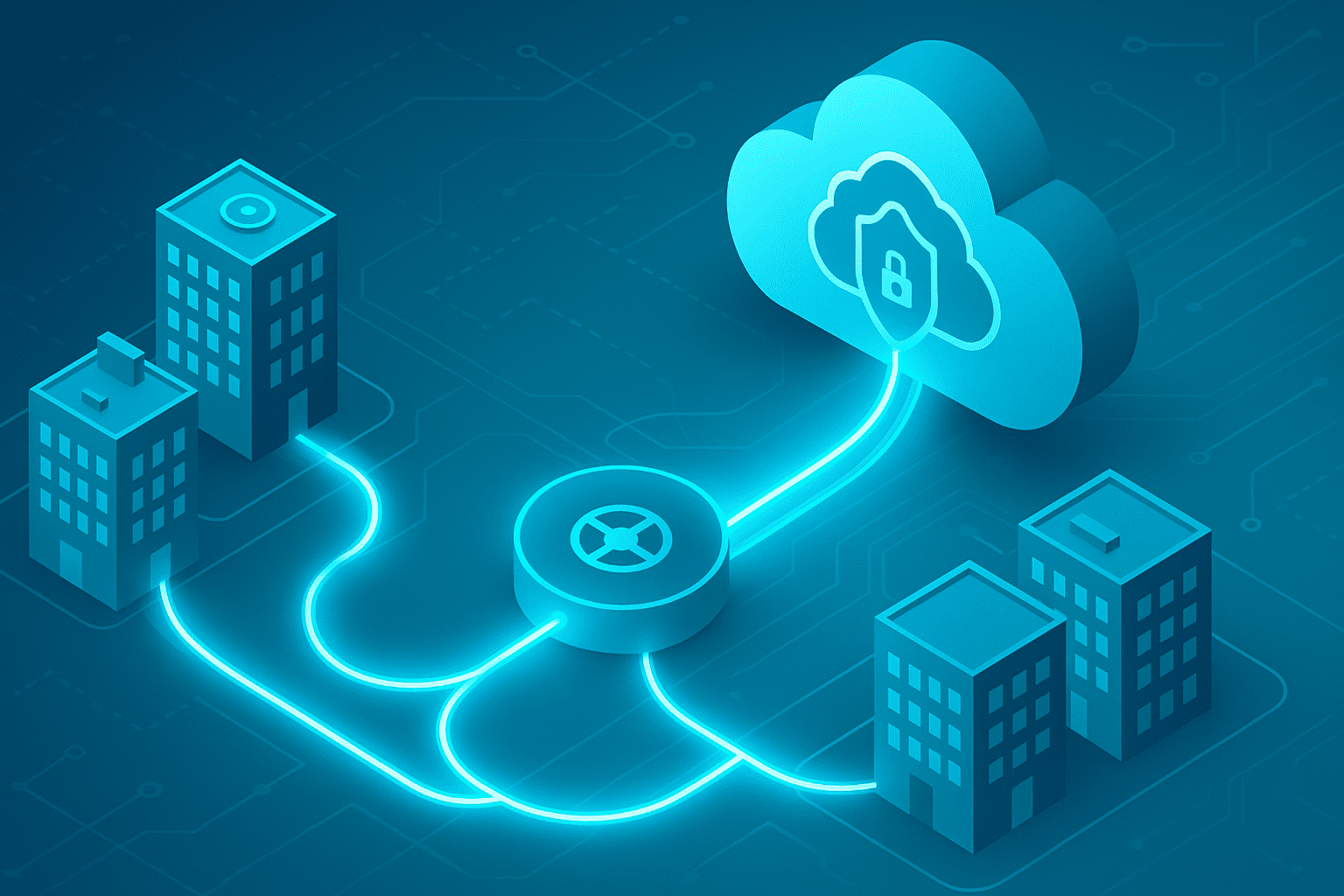Connect Enterprise Networks to the Cloud

Bridging the Gap: How a New Patent Connects Enterprise Networks to the Cloud in 8 Steps
1. The Problem This Patent Addresses in Enterprise Networking
Enterprise IT teams often struggle with connecting their private networks to public cloud environments. Traditional enterprise networks—typically built on MPLS‑based VPNs—were never designed with cloud traffic in mind[1]. When a company extends its internal network to a cloud provider’s Virtual Private Cloud (VPC), engineers must configure hardware upgrades, complex VPN tunnels, and new carrier services. For example, linking every branch office directly to an AWS VPC means spinning up separate site‑to‑site VPN tunnels, each capped at roughly 1.25 Gbps of throughput[3]. Multiply that by several branches and cloud regions, and suddenly you’re maintaining a spider web of connections that are costly and fragile. In short, enterprise and cloud networks don’t naturally speak the same language. Patent CN111742524B tackles this mismatch by proposing a scalable, software‑centric way to “stitch” an enterprise VPN to one or many cloud VPCs with far less manual effort.
2. The Core Innovation: Virtual Routing Application and Controller Approach
The patent’s secret sauce is a pair of components: a Virtual Routing Application (VRA) and a VRA Controller. Think of a VRA as a software router—a virtual machine or container that lives inside a cloud VPC. It acts as an on‑demand gateway into the enterprise network. Meanwhile, the VRA Controller (running in the enterprise WAN) is mission control: it deploys VRAs, sets up secure tunnels, and programs their routing tables[2]. The magic lies in automation. Instead of hand‑crafting individual VPNs, the controller spins up VRAs wherever the business launches workloads and instantly extends the private WAN into that VPC. Together, the controller and its fleet of VRAs stitch disparate networks into one logical fabric, dynamically choosing the best path—direct fiber, leased line, or encrypted internet tunnel—to move data between office and cloud.
3. Main Components of the System
| Component | Role in the System |
|---|---|
| Enterprise VPN Network | The company’s existing MPLS or SD‑WAN backbone connecting offices and data centers. |
| Virtual Routing Application (VRA) | Software router deployed inside each cloud VPC (and optionally on‑prem) that bridges cloud and enterprise traffic. |
| VRA Controller | Central control plane that launches VRAs, builds secure tunnels, and pushes route updates. |
| Cloud VPC | The isolated network inside a public cloud where the enterprise hosts apps and data. |
| Secure Tunnels & Paths | IPsec VPNs or dedicated links carrying encrypted traffic between enterprise sites and VRAs. |
4. How the System Works (Step‑by‑Step)
Step 1 – Deployment: Launch a VRA inside each cloud VPC and enable a controller in the enterprise core. Step 2 – Secure Connectivity: The controller forms encrypted IPsec tunnels—or uses direct lines—between the enterprise and each VRA[4]. Step 3 – Routing Setup: It then programs routes so cloud subnets look like local sites and vice‑versa. Step 4 – Seamless Integration: Branch traffic automatically selects the optimal tunnel to the closest VRA, bypassing cloud‑provider VPN gateways[5]. Step 5 – Ongoing Control: The controller monitors links, re‑routes on failure, and spins up new VRAs in minutes whenever business units deploy new VPCs. The result is one cohesive network stretching from branch routers to cloud workloads.
5. Advantages Over Traditional VPN‑to‑Cloud Setups
The VRA model slashes complexity. Instead of a “branch × region” explosion of tunnels, the entire WAN traverses a handful of shared paths[4]. That means fewer configs to manage and less hardware to buy. It also lifts throughput ceilings: traffic terminates at the VRA inside the VPC, avoiding the 1.25 Gbps cap of many managed VPN gateways[5]. Because the controller can steer flows over multiple transports, enterprises can mix premium direct connections with cheaper internet VPNs for cost‑effective resilience. Finally, each VRA doubles as a telemetry probe, giving IT teams deep visibility into performance and security events[6].
6. Ideal Users or Companies Who Benefit
Large, distributed enterprises—banks, global retailers, healthcare networks—already run private MPLS or SD‑WAN backbones and must now integrate multiple clouds. For them, VRAs turn every VPC into “just another branch,” delivering cloud agility without sacrificing security policies. Managed service providers can also package this architecture as a white‑label “cloud‑attached VPN” offering, simplifying life for mid‑sized customers who lack deep networking staff.
7. Practical Example: Old vs. New
Old method: Acme Corp’s four branches share one data‑center VPN tunnel to AWS. That single tunnel throttles at 1.25 Gbps and is a single point of failure[7]. To add redundancy, engineers must configure four more branch‑to‑cloud tunnels—20 manual steps per site.
New method: Acme deploys a VRA in AWS, turns on a VRA Controller at HQ, and lets the software spin up optimal tunnels. Branch traffic now takes the shortest encrypted path to AWS, bandwidth scales horizontally, and adding an Azure VPC tomorrow is a three‑click operation.
8. Final Takeaways
Patent CN111742524B showcases how software‑defined networking can erase the boundary between on‑prem and cloud. By pushing routing intelligence into virtual appliances and controlling them from a central brain, enterprises gain a unified, agile, and high‑performance WAN. In the hybrid‑cloud era, approaches like this transform the network from a bottleneck into a business accelerator.
References
- CN111742524B – “Enterprise VPN and Virtual Private Cloud Stitching,” lines 281‑285.
- CN111742524B – lines 239‑245.
- AWS Site‑to‑Site VPN documentation – Throughput limits per tunnel (retrieved 29 May 2025).
- CN111742524B – lines 819‑827.
- CN111742524B – lines 832‑839.
- CN111742524B – lines 354‑356.
- CN111742524B – lines 25‑33.